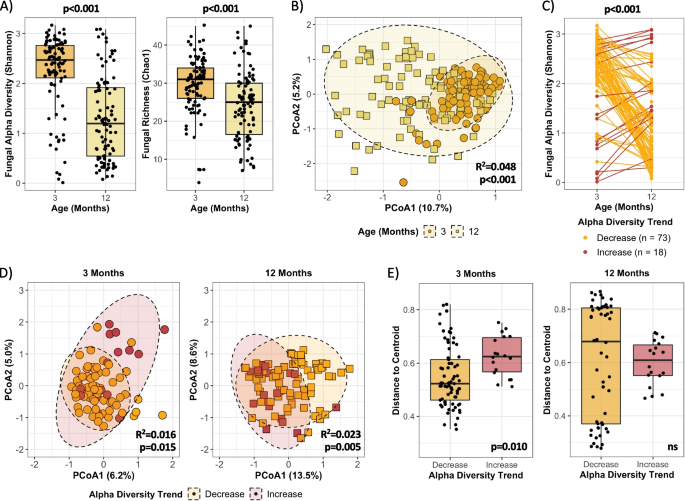💡 The study investigates the ecological succession of the gut microbiome during early life, focusing on both bacterial and fungal components. The objective is to identify individualized patterns of microbiome maturation and understand the factors influencing these patterns, with a particular emphasis on inter-kingdom dynamics.
📍 Methods: The research involves 100 infants from the CHILD Cohort Study, analyzing their gut microbiome from 3 to 12 months of age. The study integrates bacterial and fungal alpha diversity measurements, community composition analyses, and inter-kingdom dynamics. Factors such as breastfeeding, delivery mode, and prenatal exposures are considered, and metabolomic profiling is conducted to understand the functional implications of microbiome variations.
📍 Key Findings:
📌 Divergent Microbiome Maturation Patterns: Over 40% of infants exhibit divergent patterns of gut bacterial or fungal microbiome maturation.
Individual trajectories show differences in community composition, inter-kingdom dynamics, and microbe-derived metabolites, indicating variations in the timing of ecosystem transitions.
📌 Influence of Known Factors: Formula feeding and C-section delivery are associated with atypical bacterial maturation patterns.
Prenatal exposure to artificially sweetened beverages influences fungal microbiome maturation.
Breastfeeding and delivery mode influence bacterial maturation patterns but not fungal ones.
📌 Inter-Kingdom Dynamics: Bacterial and fungal alpha diversity trends are robust predictors of each other.
Inter-kingdom co-occurrence networks differ significantly in structure between typical and atypical maturational patterns, suggesting altered successional progression and community stability.
📌 Functional Implications: Metabolomic analysis reveals elevated creatine levels in infants with atypical bacterial trends, indicating potential delayed microbiome maturation.
Functional by-products of microbial metabolic pathways differ in atypical trends, suggesting broad functional effects on the host.
📌 Genetic Influence: Both maternal and infant FUT2 secretor genotype influence bacterial alpha diversity trends.
Secretor status affects microbial metabolism and gut physiology, emphasizing the complex role of genetic factors in microbiome maturation.
📌 Fungal Microbiome Dynamics: Atypical fungal alpha diversity trends are not significantly associated with known modifying factors.
Candida dominance persists in infants with atypical fungal trends, suggesting potential disruption in compositional transition dynamics.
📍 Limitations and Future Directions:
The study’s limitations include sample size constraints and the need for further validation in larger cohorts.
Future research should incorporate metagenomic analyses, repeated microbiome measures, and longitudinal health outcome data to enhance understanding.
📍 Atypical patterns of bacterial and fungal gut microbiome maturation are prevalent in infants, emphasizing the need for individualized and multi-kingdom perspectives in microbiome research.
The mycobiome plays a crucial role in bacterial microbiome establishment, and factors influencing fungal microbiome maturation differ from those commonly reported for bacteria.
The study underscores the importance of avoiding reductionist approaches in microbiome research and highlights the potential long-term consequences of divergent microbiome maturation patterns.
Link to the article : http://tinyurl.com/33vct8rk
